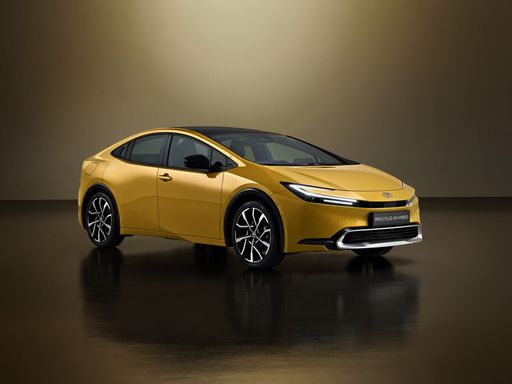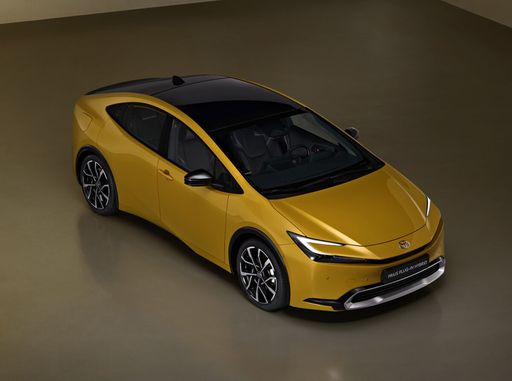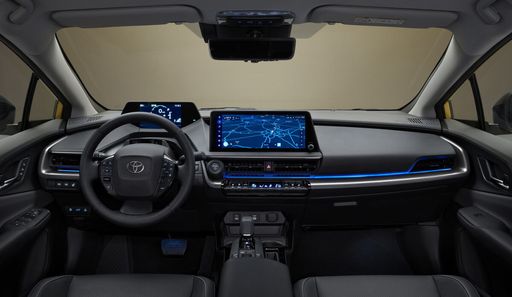Citroen Jumpy Bus VS Toyota Prius – Specs, Efficiency & Price Comparison
Which model is the better choice – the Citroen Jumpy Bus or the Toyota Prius? We compare performance (136 HP vs 223 HP), boot capacity (3497 L vs 284 L), efficiency (24.10 kWh vs 0.50 L), and of course, the price (37900 £ vs 39400 £).
Find out now which car fits your needs better!
The Citroen Jumpy Bus (Bus) is powered by a Electric engine and comes with a Automatic transmission. In comparison, the Toyota Prius (Hatchback) features a Plugin Hybrid engine and a Automatic gearbox.
When it comes to boot capacity, the Citroen Jumpy Bus offers 3497 L, while the Toyota Prius provides 284 L – depending on what matters most to you. If you’re looking for more power, you’ll need to decide whether the 136 HP of the Citroen Jumpy Bus or the 223 HP of the Toyota Prius suits your needs better.
There are also differences in efficiency: 24.10 kWh vs 0.50 L. In terms of price, the Citroen Jumpy Bus starts at 37900 £, while the Toyota Prius is available from 39400 £.
Compare all the key specs now and find out which model fits your lifestyle best!
Citroen Jumpy Bus
The Citroen Jumpy Bus offers a versatile and spacious interior, making it ideal for both family outings and professional use. Its sleek design is complemented by practical features, ensuring a comfortable and efficient driving experience. With an emphasis on adaptability, this model caters well to a variety of transportation needs, seamlessly blending functionality with style.
detailsToyota Prius
The Toyota Prius stands as a pioneer in the realm of hybrid vehicles, offering an eco-friendly driving alternative with its innovative technology. Its aerodynamic design and comfortable interior make it a practical choice for those looking to reduce their carbon footprint without sacrificing style. Additionally, the Prius boasts a reputation for reliability and efficiency, contributing to its lasting popularity among environmentally conscious drivers.
details @ Toyota
@ Toyota
 @ Toyota
@ Toyota
 @ Toyota
@ Toyota
 @ Toyota
@ Toyota

|
|
|
|
|
Costs and Consumption |
|
|---|---|
|
Price
37900 - 43900 £
|
Price
39400 - 45800 £
|
|
Consumption L/100km
-
|
Consumption L/100km
0.5 - 0.7 L
|
|
Consumption kWh/100km
24.1 - 24.4 kWh
|
Consumption kWh/100km
-
|
|
Electric Range
221 - 352 km
|
Electric Range
72 - 86 km
|
|
Battery Capacity
-
|
Battery Capacity
-
|
|
co2
0 g/km
|
co2
12 - 17 g/km
|
|
Fuel tank capacity
-
|
Fuel tank capacity
40 L
|
Dimensions and Body |
|
|---|---|
|
Body Type
Bus
|
Body Type
Hatchback
|
|
Seats
9
|
Seats
5
|
|
Doors
4
|
Doors
5
|
|
Curb weight
2018 - 2240 kg
|
Curb weight
1620 - 1630 kg
|
|
Trunk capacity
3061 - 3497 L
|
Trunk capacity
284 L
|
|
Length
4983 - 5333 mm
|
Length
4599 mm
|
|
Width
1920 mm
|
Width
1782 mm
|
|
Height
1895 - 1935 mm
|
Height
1470 mm
|
|
Payload
850 - 982 kg
|
Payload
365 - 375 kg
|
Engine and Performance |
|
|---|---|
|
Engine Type
Electric
|
Engine Type
Plugin Hybrid
|
|
Transmission
Automatic
|
Transmission
Automatic
|
|
Transmission Detail
-
|
Transmission Detail
-
|
|
Drive Type
Front-Wheel Drive
|
Drive Type
Front-Wheel Drive
|
|
Power HP
136 HP
|
Power HP
223 HP
|
|
Acceleration 0-100km/h
-
|
Acceleration 0-100km/h
6.80 s
|
|
Max Speed
130 km/h
|
Max Speed
177 km/h
|
|
Torque
260 Nm
|
Torque
-
|
|
Number of Cylinders
-
|
Number of Cylinders
4
|
|
Power kW
100 kW
|
Power kW
164 kW
|
|
Engine capacity
-
|
Engine capacity
1998 cm3
|
General |
|
|---|---|
|
Model Year
2024
|
Model Year
2023
|
|
CO2 Efficiency Class
A
|
CO2 Efficiency Class
B
|
|
Brand
Citroen
|
Brand
Toyota
|
Citroen Jumpy Bus
The Citroen Jumpy Bus: A Modern Marvel of Mobility
The Citroen Jumpy Bus stands out as a paragon of modern transportation innovation, bringing together style, efficiency, and advanced technology in one impressive package. As a pioneer in electric vehicle solutions, Citroen has equipped the Jumpy Bus with a host of technological advancements that cater to both eco-conscious individuals and professional users who seek functionality without sacrificing environmental responsibility.
Efficient and Eco-Friendly Performance
At the heart of the Citroen Jumpy Bus is its fully electric powertrain, offering a performance level that matches its petrol and diesel counterparts without the associated emissions. The vehicle boasts a maximum power output of 136 PS (100 kW) and a robust torque of 260 Nm, ensuring smooth and responsive driving. The CO2 emissions from this model remain impeccably non-existent at 0 g/km, highlighting its dedication to environmental conservation.
Range and Charging: Going the Extra Kilometre
The Citroen Jumpy Bus offers a significant electric range, varying between an impressive 221 to 352 kilometres, depending on the configuration. This extended range ensures that the vehicle can accommodate longer journeys and less frequent charges, making it ideal for both urban commuting and intercity travel.
Interior Design: Comfort Meets Versatility
Inside, the Jumpy Bus provides seating for up to nine passengers, blending comfort with practicality. The spacious interior and ample storage capacity of between 3061 to 3497 litres make it an excellent choice for family trips or transporting goods. With a loading capacity ranging from 850 to 982 kg, this vehicle does not compromise on space or flexibility.
High-Tech Features and Safety
Safety and technology are of paramount importance in the Citroen Jumpy Bus. Equipped with advanced driver assistance systems, the model ensures optimal security for occupants. Its automatic gearbox, specifically a reduction gearbox, further enhances the driving experience by enabling seamless gear transitions, reducing driver fatigue, and improving energy efficiency.
Dimensions and Practicality
Measuring between 4983 to 5333 mm in length, and with a width of 1920 mm, the Citroen Jumpy Bus combines significant interior space with a manageable external footprint. This balance allows it to navigate urban environments with ease while still offering the functionality expected of a larger vehicle. With a height of 1895 to 1935 mm, the vehicle maintains a sleek profile, contributing to its aerodynamic efficiency.
Conclusion: A Vehicle for the Future
Priced between €44,230 and €51,230, the Citroen Jumpy Bus presents itself as a competitive option for those seeking an efficient, environmentally friendly, and versatile vehicle. Its myriad of innovative features and state-of-the-art technology underscore Citroen's commitment to future mobility solutions, making it a leader in the modern automotive landscape.
Toyota Prius
The All-New Toyota Prius: Revolutionising Efficiency and Performance
The Toyota Prius, a name synonymous with hybrid innovation, has once again shown why it remains at the forefront of eco-friendly automotive technology. The latest models have enhanced technical features and innovations, setting new standards for efficiency and driving experience.
Hybrid Performance: A Leap Forward
The latest Prius models employ a sophisticated 2.0 litre Plug-in Hybrid system that flawlessly melds petrol and electric power. With a power output of 223 PS, it propels the Prius with impressive dynamism, reaching 0-100 km/h in just 6.8 seconds. This performance-oriented aspect of the Prius does not compromise on efficiency, with an astonishing fuel consumption ranging from 0.5 to 0.7 L/100km.
Electric Range and Efficiency
One of the key highlights of the new Prius is its substantial electric-only range. Depending on the variant, it can travel between 72 to 86 km on electric power alone, making it an ideal choice for urban commutes where zero emissions are preferred. The hybrid system's CO2 emissions are remarkably low, between 12 and 17 g/km, contributing to its CO2 Efficiency Class B rating.
Engineering Excellence with CVT
The Prius is equipped with a state-of-the-art Continuously Variable Transmission (CVT), ensuring a smooth and efficient drive. This advanced transmission supports the front-wheel-drive layout, delivering power seamlessly and enhancing driving pleasure without sacrificing fuel economy.
Stylish Design and Comfort
Designed as a sleek five-door hatchback, the Prius offers a comfortable and spacious interior with seating for five passengers. It measures 4599 mm in length, 1782 mm in width, and 1470 mm in height, offering a practical balance of size and comfort. The boot space, while tailored for the hybrid battery, still provides a decent 284 litres of storage.
Cost Efficiency
The running costs of the Prius are competitive, with monthly expenses estimated between €1064 and €1188, and cost per kilometre ranging from 42.6 to 47.5 cents. Its efficient design results in a maximum speed of 177 km/h and a practical fuel tank size of 40 litres, ensuring less frequent stops on longer journeys.
Conclusion: The Prius Legacy Continues
The Toyota Prius continues to lead by example in the realm of hybrid technology. Combining impressive power with unmatched efficiency and a sophisticated driving experience, it is clear that the Prius remains a compelling choice for the environmentally conscious driver. Its innovative features and favourable cost metrics only bolster its appeal in the modern automotive landscape.
The prices and data displayed are estimates based on German list prices and may vary by country. This information is not legally binding.
